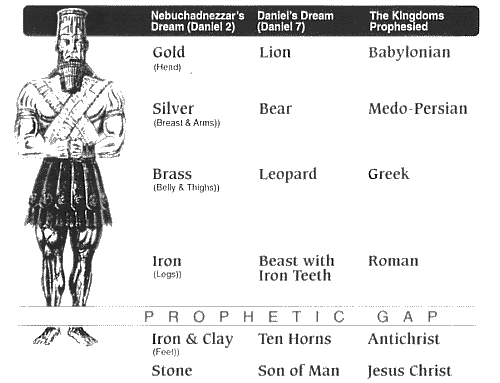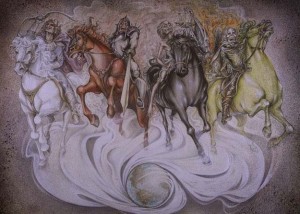Ken Klein sent me a reply today asking me to apologize for my video commentary to his heretical teaching on original sin. The issue is that Ken denies the orthodox biblical doctrine of original sin, as the clips in the video evidence. He opposes the clear teaching of the Apostle Paul and I called him on it. Now he is threatening to sick his attorney’s on me. Ken’s posts are indented in block quotes, my responses are marked Logos:
—————————–
****Due the length of Ken’s post and the fact that he basically defends his use of elohim for a plurality of angelic beings, something I never disputed, it is linked here. ****
I am impressed to say for the sake of a laying a foundation: Jesus is my Lord and Savior. Jesus Christ is the common denominator that gives union to all believers even through their are differences of view points. Yes, I believe in the Trinity and I do embrace an insight on that subject.
It is unfortunate that you have not done due diligence on who I am before trying to assassinate my character. I would ask you to take down the video because it violates copyright laws, youtube policies, and includes slanderous accusations as to my motives and character.
I forgive you.
Ken
——————————-
Logos:
Sorry but this does not address the issue that sin entered the world through Adam, through one man not because we are fallen angels working off past rebellion. Paul makes that crystal clear. You don’t have a biblical leg to stand on.
——————————
Ken:
Expected a more thoughtful response from someone who calls themselves Logos.
———————————
Logos:
I was brief, I am really busy at the seminary this week. I don’t see how any of this addresses the real issue. I made it clear in the video: http://www.logosapologia.org/?p=206. I am familiar with the Divine Council concept and have studied the work of Dr Michael Heiser, so the idea of little ‘g’ gods is nothing new. That was never my problem with your theology. It’s that you blatanly mocked the doctrine of original sin Ken.
Further, the very temptation to “be like God, knowing good and evil” (Gen. 3:5) implies they did not know evil before they fell. Indeed, when they ate the forbidden fruit, “the eyes of both of them were opened, and they realized they were naked; so they sewed fig leaves together and made coverings for themselves” (3:7). According to the New Testament, by disobedience Adam and Eve became sinful (Rom. 5:12; 1 Tim. 2:14) and brought condemnation on themselves and their posterity: “The result of one trespass was condemnation for all men” (Rom. 5:18).3 Before this, they were flawless.
Source: Geisler, Norman L.: Systematic Theology, Volume Three: Sin, Salvation. Minneapolis, MN : Bethany House Publishers, 2004, S. 17
In your video it wasn’t Adam’s sin. No, you said that wasn’t fair of God. Your words Ken, “It’s not fair!” So you created this new revelation that it was our sin as as pre-incarnate angels? You are directly contradicting the Apostle Paul’s teaching. That’s what I was responding to Ken, it was clear enough. You do not have the authority to “correct” Paul because you don’t think it’s fair, Ken.
As far as taking down the video look into : Fair use is a doctrine in United States copyright law that allows limited use of copyrighted material without requiring permission from the rights holders, such as for commentary, criticism, news reporting, research, teaching or scholarship.
——————————
Ken:
Consider the very scripture you brought up to support your interpretive doctrine of “Original Sin”. If sin had to enter through Adam, then sin had to already be in existence, and by definition cannot be original. For something that doesn’t exist cannot enter.
“By the way it was Eve that sinned according to Timothy. So how did sin enter through Adam?”
We are not mocking the terrible nature of sin, but rather how the current and traditional Christian doctrine of sin is such a feeble representation of the magnitude of sin. And the way it is represented, makes God out to look like a cruel rather than loving God.
His very nature is maligned by the poorly interpreted doctrine that you hold to.
Ken
P.S. I’m very aware of “fair usage laws” as a film producer and you aren’t in alignment with those laws. If you still refuse to take it down then you will hear from my attorney.
————————————–
This was the point where I decided to take it public. I will stand on the Fair Use provision. Ken is threatening me with his attorney. I am clearly using clips of his video for criticism and commentary which is the very reason the fair use provision was enacted. You tube isn’t too sympathetic about false DMCA’s being filed. But what is really important is exposing Ken’s false teaching and bad theology.
_______________________
Ken: Consider the very scripture you brought up to support your interpretive doctrine of “Original Sin”. If sin had to enter through Adam, then sin had to already be in existence, and by definition cannot be original. For something that doesn’t exist cannot enter.
————————————
Logos:
This is really your argument? Sin is a metaphysical bogeyman that pre-existed Adam. Seriously? Sin means disobedience to God’s standard. It was original to humanity, Adam being the first human. Due to that, today we have an inherited sin nature but as Dr Geisler pointed out in the entry above there was a state of innocence in the original creation. This is not an interpretative matter Ken. You teach that all of humanity sinned as pre-incarnate angels and we are here on earth working off our error by our own righteous choice. That is wrong on many levels. It qualifies as heresy and it is the duty of apologists to refute such error. The Bible explicitly says that one transgression led to the condemnation for all men.
“Therefore, as one trespass led to condemnation for all men, so one act of righteousness leads to justification and life for all men. For as by the one man’s disobedience the many were made sinners, so by the one man’s obedience the many will be made righteous. ” (Romans 5:18–19, ESV)
How do you explain this scripture Ken?
Ken: “By the way it was Eve that sinned according to Timothy. So how did sin enter through Adam?”
According to Timothy? Sorry Ken but the Apostle Paul (the same guy that wrote “by one man’s disobedience”) wrote 1st Timothy. I suppose you are referring to “For Adam was formed first, then Eve; and Adam was not deceived, but the woman was deceived and became a transgressor. ” (1 Timothy 2:13–14, ESV) Paul’s point here is that Eve was deceived by the Serpent. Adam was not deceived, he knew better. Adam willfully chose to disobey. A man is the spiritual leader of his household by God’s design and when God inquired (Gen 3:9) he called Adam’s name. That’s the distinction Paul was making. This is really basic biblical theology Ken. You should know better.
Ken: We are not mocking the terrible nature of sin, but rather how the current and traditional Christian doctrine of sin is such a feeble representation of the magnitude of sin. And the way it is represented, makes God out to look like a cruel rather than loving God.
His very nature is maligned by the poorly interpreted doctrine that you hold to.
It’s not just the “current and traditional” doctrine. It’s the apostolic teaching. It’s at the core of Biblical Christianity. It’s a non negotiable. Ken, I believe God’s revealed truth in holy scripture, “as one trespass led to condemnation for all men,” it is not an interpretive matter. You either believe the Bible or you do not. It’s a matter of submission to Biblical authority. You said that you don’t think it was fair that you inherited Adam’s sin. Ken you are the one maligning God’s character with, “It’s not fair”. Actually, it’s really not fair that Jesus died for me. So I am glad it’s not fair. If it was really fair, I would go to hell. No Ken, I didn’t choose to work off my pre-incarnate angelic transgressions. God was merciful. Ken you simply reject the clear teaching of scripture and have manufactured a new revelation to “correct” it. It’s nothing new. So did Joseph Smith, Alice Bailey, Mary Baker Eddy, David Koresh and Muhammad. That’s what cults do Ken.





